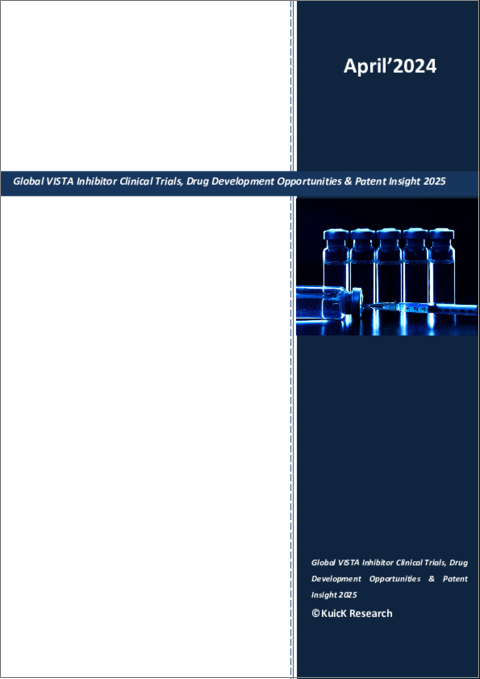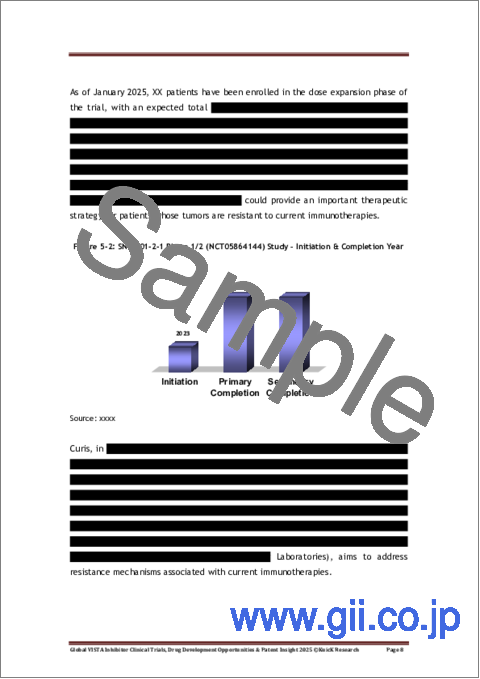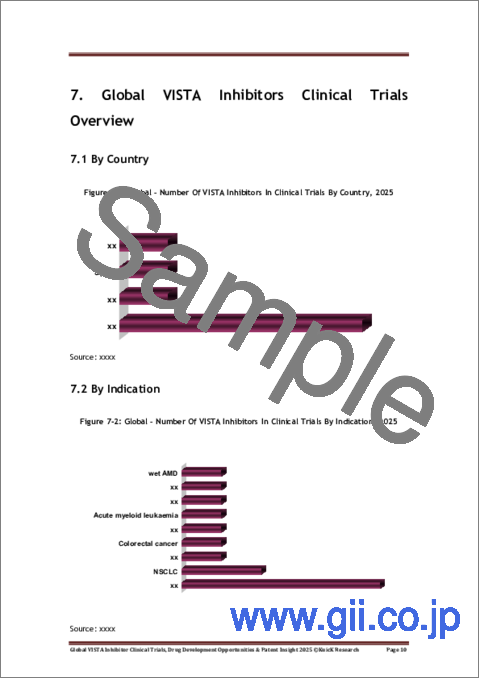|
|
市場調査レポート
商品コード
1692592
VISTA阻害剤の世界市場:臨床試験、医薬品開発の機会、特許の洞察(2025年)Global VISTA Inhibitor Clinical Trials, Drug Development Opportunities & Patent Insight 2025 |
||||||
|
|||||||
| VISTA阻害剤の世界市場:臨床試験、医薬品開発の機会、特許の洞察(2025年) |
|
出版日: 2025年04月01日
発行: KuicK Research
ページ情報: 英文 75 Pages
納期: 即日から翌営業日
|
全表示
- 概要
- 図表
- 目次
免疫チェックポイント阻害剤が様々な悪性腫瘍の治療アプローチに革命をもたらし、がん免疫療法の状況は近年著しい変貌を遂げています。ペムブロリズマブやニボルマブといった第一世代の免疫チェックポイント阻害剤が大成功を収めたことで、研究者たちは現在、より新しい免疫チェックポイントタンパク質の同定に力を注いでいます。この革新的な分野における次世代ターゲットとして浮上しているのがVドメイン免疫グロブリンT細胞活性化抑制因子(VISTA)です。
重要な免疫チェックポイント蛋白質であるVISTAは、特に腫瘍微小環境内での免疫応答の制御において微妙な役割を果たしています。PD-1やCTLA-4のような、より広く研究されているチェックポイント分子とは異なり、VISTAは未開拓の可能性を秘めた比較的新しい標的です。T細胞の活性化を調節し、抗腫瘍免疫応答を抑制する上でVISTAが重要であることは調査により次第に認識されつつあり、VISTAは標的免疫療法戦略の興味深い候補となっています。
現在の免疫療法の状況は、既存の免疫チェックポイント阻害剤の目覚ましい成功と類似しており、VISTAを標的としたアプローチに大きな期待が持てることを示しています。PD-1阻害剤とCTLA-4阻害剤の画期的な成果は、より洗練された精密な免疫調節介入への道を開いた。これらの前例は、VISTAのような新規チェックポイント標的を探索する上で、確固たる科学的検証と投資家の信頼を提供し、変革的な治療アプローチの可能性を示唆しています。
VISTA標的治療における最も有望な開発のひとつが、Aurigene OncologyとCurisが開発した革新的な経口低分子化合物CA-170です。この化合物は、VISTAとPD-L1の両方を標的とする洗練された二重阻害剤であり、従来の抗体ベースのアプローチと比較していくつかの魅力的な利点を提供します。この分子は経口投与が可能であり、複雑さを軽減し、免疫関連の有害事象をより管理しやすくする可能性があり、従来の免疫療法戦略とは一線を画しています。
Aurigene OncologyとCurisの戦略的提携は、VISTA標的治療薬に対する大きな関心と商業的可能性を浮き彫りにするものです。開発権を異なる地域に分割することで、この提携はVISTAの治療可能性を世界の科学界が認識していることを強調しています。現在進行中の後期臨床試験、特に非小細胞肺がんにおけるCA-170の有効性を調査する第2b/3相試験は、この分子の臨床的有用性を理解する上で重要なマイルストーンとなります。
前臨床および初期段階の調査により、VISTAの複雑な免疫調節メカニズムが明らかになりました。いくつかのチェックポイント蛋白質とは異なり、VISTAはT細胞応答を抑制するというユニークな特徴を示し、がん免疫療法への微妙な影響を示唆しています。予備的研究では、VISTAの阻害が抗腫瘍免疫応答を再活性化する可能性があり、既存のチェックポイント阻害戦略に対する補完的あるいは代替的なアプローチを提供することが示されています。
VISTAを標的とした治療法が承認されていないことは、研究者や医薬品開発者にとって課題であると同時にチャンスでもあります。この治療領域は未知の領域であるため、革新的なアプローチが可能であり、VISTAの潜在的メカニズムを創造的に探求することができます。研究者は、他のチェックポイント阻害剤で観察される耐性メカニズムを克服するVISTAの可能性に特に興味をそそられており、治療抵抗性の悪性腫瘍患者に新たな希望をもたらす可能性があります。
科学界が免疫調節におけるVISTAの複雑な役割を解明し続けるにつれて、今後数年間は研究と臨床開発が加速されることが予想されます。免疫反応をより正確に調節できる標的治療薬の開発の可能性は、個別化医療における大きな進歩を意味します。課題は残るもの、基礎研究と現在進行中の臨床研究は、VISTAを標的とした治療戦略にとって楽観的な展望を描いています。
当レポートは、世界のVISTA阻害剤市場について調査し、市場の概要とともに、薬剤動向、臨床試験動向、地域別動向、および市場に参入する企業の競合情勢などを提供しています。
目次
第1章 新たな免疫チェックポイントとしてのVISTA
- VISTA阻害とは何か
- VISTAタンパク質の構造と生物学
- VISTA阻害剤の作用機序
第2章 阻害および共刺激チェックポイントとしてのVISTA
- 抑制性免疫チェックポイントとしてのVISTA
- 共刺激チェックポイントとしてのVISTA
- VISTA阻害剤と従来の免疫チェックポイント阻害剤の比較
第3章 疾患の進行と治癒におけるVISTAの重要性
- がんの進行を促進するVlSTAの役割
- VISTAは潜在的ながんバイオマーカー
- 自己免疫疾患の治療標的としてのVISTA
第4章 世界のVISTA阻害剤市場と臨床開発の展望
- 現在のシナリオ
- 将来の機会
第5章 VISTA標的療法の動向と適応症別の臨床イノベーション
- 固形がん
- 血液がん
- 自己免疫疾患および炎症性疾患
第6章 VISTA標的治療の地域動向と臨床イノベーション
- 米国
- 欧州
- インド
- オーストラリア
第7章 VISTA阻害剤の世界臨床試験の概要
- 国別
- 適応症別
- 組織別
- 相別
第8章 企業、国、適応症、相別のVISTA阻害剤の臨床試験に関する世界な洞察
- 前臨床
- 第I相
- 第I/II相
- 第III相
第9章 世界のVISTA阻害剤市場力学
- 市場の促進要因
- 市場の課題
第10章 競合情勢
- Aurigene Discovery Technologies
- Curis
- Hummingbird Bioscience
- Kineta
- PharmAbcine
- Sensei Biotherapeutics
List of Figures
- Figure 1-1: VISTA Protein - Structure
- Figure 1-2: VISTA - Binding Partners
- Figure 1-3: VISTA Inhibition - Basic Mechanism
- Figure 2-1: VISTA - Role In Cancer Immunotherapy
- Figure 2-2: VISTA - Role In Autoimmune Diseases
- Figure 2-3: VISTA Inhibition - Edge Over Conventional Checkpoint Inhibition
- Figure 3-1: VISTA Interaction With Immune Cells
- Figure 3-2: VISTA - Mechanisms Of Immune Suppression
- Figure 3-3: Dual Role Of VISTA In Cancer
- Figure 3-4: VISTA As Predictive Biomarker
- Figure 3-5: Autoimmune Diseases - VISTA Agonism
- Figure 4-1: Future Market Opportunities
- Figure 5-1: Solid Tumors - VISTA Role In Tumor Immune Evasion
- Figure 5-2: SNS-101-2-1 Phase 1/2 (NCT05864144) Study - Initiation & Completion Year
- Figure 5-3: HMBD-002-V4C26-01 Phase 1/2 (NCT05082610) Study - Initiation & Completion Year
- Figure 5-4: Hematological Cancers - Mechanisms Of Immune Evasion By VISTA
- Figure 5-5: Autoimmune & Inflammatory Disorders - VISTA As Ligand On APCs
- Figure 5-6: Autoimmune & Inflammatory Disorders - VISTA As Receptor On T Cells
- Figure 5-7: Kings College London & Dartmouth College VISTA Patent - Grant & Expiration Year
- Figure 6-1: MarkV-01/KEYNOTE-E80 Phase 1 (NCT05957081) Study - Initiation & Completion Year
- Figure 7-1: Global - Number Of VISTA Inhibitors In Clinical Trials By Country, 2025
- Figure 7-2: Global - Number Of VISTA Inhibitors In Clinical Trials By Indication, 2025
- Figure 7-3: Global - Number Of VISTA Inhibitors In Clinical Trials By Organization, 2025
- Figure 7-4: Global - Number Of VISTA Inhibitors In Clinical Trials By Phase, 2025
- Figure 9-1: Market Drivers & Opportunities
- Figure 9-2: Market Challenges & Restraints
List of Tables
- Table 5-1: VISTA - Role In Autoimmune & Inflammatory Disorders
- Table 6-1: US - Ongoing Clinical Trials for VISTA Inhibitors
Global VISTA Inhibitor Clinical Trials, Drug Development Opportunities & Patent Insight 2025 Report Highlights & Findings:
- First VISTA Inhibitor Drug Approval By 2028
- US Dominating Global VISTA Inhibitor Clinical Trials Landscape
- Insight On Ongoing Clinical Trials By Company, Country, Indication & Phase
- Key Drugs Clinical Study Initiation & Completion Year Overview
- Global & Regional Market Development Insight By Indication
- Global VISTA Inhibitors Market Dynamics & Competitive Landscape
The landscape of cancer immunotherapy has witnessed remarkable transformations in recent years, with immune checkpoint inhibitors revolutionizing treatment approaches for various malignancies. With the massive success of first generation immune checkpoint inhibitors, such as pembrolizumab and Nivolumab, researchers have now focused their efforts in identifying newer immune checkpoint proteins. Among the emerging next-generation targets in this innovative field is the V-domain immunoglobulin suppressor of T cell activation (VISTA), which represents a promising yet under-explored avenue for potential therapeutic interventions across a range of indications.
VISTA, a critical immune checkpoint protein, plays a nuanced role in regulating immune responses, particularly within the tumor microenvironment. Unlike more extensively studied checkpoint molecules like PD-1 and CTLA-4, VISTA remains a relatively nascent target with significant untapped potential. Researchers have increasingly recognized its importance in modulating T cell activation and suppressing anti-tumor immune responses, making it an intriguing candidate for targeted immunotherapeutic strategies.
The current immunotherapy landscape demonstrates considerable promise for VISTA targeted approaches, drawing parallels with the remarkable success of existing immune checkpoint inhibitors. The groundbreaking achievements of PD-1 and CTLA-4 inhibitors have paved the way for more sophisticated and precise immunomodulatory interventions. These precedents provide robust scientific validation and investor confidence in exploring novel checkpoint targets like VISTA, suggesting a potentially transformative therapeutic approach.
Among the most promising developments in VISTA targeted therapy is CA-170, an innovative oral small molecule developed by Aurigene Oncology and Curis. This compound represents a sophisticated dual inhibitor targeting both VISTA and PD-L1, offering several compelling advantages over traditional antibody-based approaches. The molecule's oral administration format, reduced complexity, and potential for more manageable immune-related adverse events distinguish it from conventional immunotherapeutic strategies.
The strategic collaboration between Aurigene and Curis highlights the significant interest and potential commercial viability of VISTA targeted therapies. By dividing development rights across different geographical regions, the partnership underscores the global scientific community's recognition of VISTA's therapeutic potential. The ongoing late-phase clinical trials, particularly the phase 2b/3 studies investigating CA-170's efficacy in non-small cell lung cancer, represent a critical milestone in understanding the molecule's clinical utility.
Preclinical and early stage research has unveiled VISTA's complex immunomodulatory mechanisms. Unlike some checkpoint proteins, VISTA exhibits unique characteristics in suppressing T cell responses, suggesting nuanced implications for cancer immunotherapy. Preliminary studies indicate that VISTA's inhibition could potentially reinvigorate anti-tumor immune responses, offering a complementary or alternative approach to existing checkpoint blockade strategies.
The lack of approved VISTA-targeted therapies presents both a challenge and an opportunity for researchers and pharmaceutical developers. The uncharted nature of this therapeutic domain invites innovative approaches and allows for creative exploration of VISTA's potential mechanisms. Researchers are particularly intrigued by VISTA's potential in overcoming resistance mechanisms observed with other checkpoint inhibitors, potentially offering new hope for patients with treatment-resistant malignancies.
Scientific interest in VISTA extends beyond oncology, with emerging research suggesting potential applications in autoimmune disorders and inflammatory conditions. This broader therapeutic landscape further amplifies the molecule's significance and underscores the importance of continued investigative efforts. The multifaceted nature of VISTA's immunomodulatory functions presents a complex yet exciting frontier for translational research.
As the scientific community continues to unravel VISTA's intricate roles in immune regulation, the coming years are likely to witness accelerated research and clinical development. The potential for developing targeted therapies that can modulate immune responses with greater precision represents a significant advancement in personalized medicine. While challenges remain, the foundational research and ongoing clinical investigations paint an optimistic picture for VISTA-targeted therapeutic strategies.
Table of Contents
1. VISTA As Emerging Immune Checkpoint
- 1.1 What Is VISTA Inhibition?
- 1.2 Structure & Biology Of VISTA Protein
- 1.3 Mechanism Of Action Of VISTA Inhibitors
2. VISTA As Inhibitory & Costimulatory Checkpoint
- 2.1 VISTA As Inhibitory Immune Checkpoint
- 2.2 VISTA As Costimulatory Checkpoint
- 2.3 VISTA Inhibition v/s Conventional Immune Checkpoint Inhibitors
3. Significance Of VISTA In Disease Progressiopn & Cure
- 3.1 Role Of VlSTA In Facilitating Cancer Progression
- 3.2 VISTA As Potential Cancer Biomarker
- 3.3 VISTA As Therapeutic Target In Autoimmune Diseases
4. Global VISTA Inhibitors Market & Clinical Development Outlook
- 4.1 Current Scenario
- 4.2 Future Opportunities
5. VISTA Targeted Therapies Trends & Clinical Innovation By Indication
- 5.1 Solid Cancers
- 5.2 Hematological Cancers
- 5.3 Autoimmune & Inflammatory Disorders
6. VISTA Targeted Therapies Trends & Clinical Innovation By Region
- 6.1 US
- 6.2 Europe
- 6.3 India
- 6.4 Australia
7. Global VISTA Inhibitors Clinical Trials Overview
- 7.1 By Country
- 7.2 By Indication
- 7.3 By Organization
- 7.4 By Phase
8. Global VISTA Inhibitors Clinical Trials Insight By Company, Country, Indication & Phase
- 8.1 Preclinical
- 8.2 Phase I
- 8.3 Phase I/II
- 8.4 Phase III
9. Global VISTA Inhibitors Market Dynamics
- 9.1 Market Drivers
- 9.2 Market Challenges
10. Competitive Landscape
- 10.1 Aurigene Discovery Technologies
- 10.2 Curis
- 10.3 Hummingbird Bioscience
- 10.4 Kineta
- 10.5 PharmAbcine
- 10.6 Sensei Biotherapeutics





